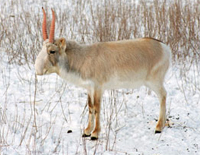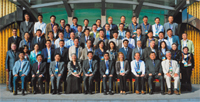 At a workshop on the conservation and sustainable use of the saiga antelope, representatives of the Traditional Chinese Medicine (TCM) industry – which uses saiga horn in several medical products – confirmed their willingness to do their part in restoring wild saiga populations.
At a workshop on the conservation and sustainable use of the saiga antelope, representatives of the Traditional Chinese Medicine (TCM) industry – which uses saiga horn in several medical products – confirmed their willingness to do their part in restoring wild saiga populations.
The objective of the workshop, convened by the CITES Management Authority of China and the Secretariats of CITES and CMS in Urumqi, Xinjiang Uygur Autonomous Region, China (27-29 September 2010), was to strengthen international cooperation among consumer and range States and to provide a platform for discussion between those managing in situ or ex situ conservation activities and the Asian traditional medicine industry. The idea of sharing conservation efforts between consumer and range States is reflected in Decisions adopted at the 15th meeting of the Conference of the Parties to CITES (CoP15, Doha, 2010) and has been envisaged since 2006 under the CMS Memorandum of Understanding concerning 'Conservation, Restoration and Sustainable Use of the Saiga Antelope' (CMS Saiga MoU).
 More than 70 participants discussed avenues for closer collaboration at the Urumqi workshop. They represented government agencies and institutes responsible for CITES, wildlife, biodiversity and Customs in Kazakhstan, Mongolia, the Russian Federation and Uzbekistan (where saiga populations exist today); national and subnational government agencies and institutes in China responsible for CITES, wildlife, forestry, health and Customs; the Traditional Chinese Medicine Association as well as a number of its member enterprises, and TRAFFIC/WWF China. International experts were also invited. Among other things, participants recommended the establishment of a fund or other enabling mechanism through which the TCM industry could become involved with in situ conservation and restoration efforts that addressed identified and mutually agreed priorities (e.g. to implement relevant CITES CoP15 Decisions and the 2011-2015 Medium-Term Work Programme under the CMS Saiga MoU).
More than 70 participants discussed avenues for closer collaboration at the Urumqi workshop. They represented government agencies and institutes responsible for CITES, wildlife, biodiversity and Customs in Kazakhstan, Mongolia, the Russian Federation and Uzbekistan (where saiga populations exist today); national and subnational government agencies and institutes in China responsible for CITES, wildlife, forestry, health and Customs; the Traditional Chinese Medicine Association as well as a number of its member enterprises, and TRAFFIC/WWF China. International experts were also invited. Among other things, participants recommended the establishment of a fund or other enabling mechanism through which the TCM industry could become involved with in situ conservation and restoration efforts that addressed identified and mutually agreed priorities (e.g. to implement relevant CITES CoP15 Decisions and the 2011-2015 Medium-Term Work Programme under the CMS Saiga MoU).
Background information on the saiga antelope
The saiga antelope is listed on Appendix II of both CITES and CMS and became protected by national legislation throughout its range as a result of a sudden population decline from 1 million to less than 50,000 animals in the 1990s. The decline may be attributable to the combined effects of changes to the vegetation, competition with domestic livestock, increased abundance of predators, disruption to migration routes, poaching and illegal trade. Today, approximately 100,000 saigas are estimated to roam the steppes and deserts of Eurasia and individual populations are beginning to stabilize or even increase. Exports of horn are currently prohibited through national legislation to allow populations to recover. Several countries have established captive-breeding centres for saigas and there may be potential for re-introducing captive-bred animals into the wild.